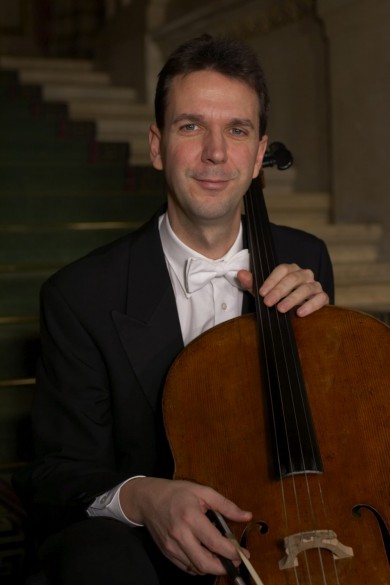Cellist Varga joins New World players for absorbing Austrian program

Tamás Varga, principal cellist of the Vienna Philharmonic, performed with New World Symphony members in Sunday’s chamber program. Photo: Wilfried Hedenborg
While Erich Wolfgang Korngold is best known today for the scores he wrote for Hollywood melodramas and swashbucklers in the 1930’s and 40’s, he was hailed as a prodigy of genius proportions in early 20th-century Vienna by no less than Mahler and Richard Strauss. The New World Symphony revived Korngold’s String Sextet in D Major on Sunday afternoon, capping an absorbing program of Austrian chamber music at New World Center.
Korngold’s connection to the artists and musical ethos of Vienna was deep. His father was a leading music critic and the Rose Quartet were among the players who premiered the sextet in 1916—the same group that gave the first performances of Brahms’ String Quartet No. 2 and Clarinet Quintet. The work of an 18-year-old wunderkind, the sextet is dipped in candied textures and sonorities that could only have come from fin-de-siècle Vienna. This is unabashedly romantic music, replete with sprawling melodic writing and tumultuous climaxes.
The first of the score’s four movements comprises almost one third of its 33 minute length. Two violins take the lead in tossing radiant melodies around one minute and pounding march-like motifs the next. In the Adagio, harmonies become more unmoored and instrumental lines overlap, suggesting Korngold’s familiarity with the contemporaneous work of Arnold Schoenberg. The Intermezzo opens with an ardent theme that sounds remarkably like one from Korngold’s Violin Concerto before morphing into Viennese waltzes of the Rosenkavalier variety. A series of fast-paced figurations set the Presto finale on its diverting paths. Korngold’s work is a delightful entertainment soufflé, masterfully conceived with graceful instrumental writing.
Tamás Varga, principal cellist of the Vienna Philharmonic for over two decades, played the first cello part and coached New World players in a performance of surpassing excellence. The dark-hued resonance of Jessica Pasternak’s solo viola, Varga and Nicholas Mariscal’s amber-toned cellos and the playing of violinists Zachary Ragent and Teddy Wiggins and violist Spencer Ingersoll offered standout moments in an intense and beautiful performance. All the players matched the richness and depth of Varga’s sound compass.
Schoenberg’s Chamber Symphony No. 2 was begun in 1906 among the same Viennese milieu as Korngold’s work and completed in 1939 when Schoenberg was living in Los Angeles. He had traveled a huge distance in those tears between the angst-ridden romanticism of Mahler to the pathbreaking vistas of atonality. Although the symphony represents a temporary return to tonal composition for Schoenberg, his creative journey is fully evident in the work’s two movements.
The initial Adagio is passionate, volatile and melancholy, replete with lush string sonorities. A different sound world pervades the Con fuoco finale in which thorny string and wind fragments collide and overlap. At times the music turns into a deranged waltz, a nightmare version of Liszt’s Mephisto dances. Despite its divergent musical language, the symphony is immensely appealing, filled with enlivening incidents and vibrant instrumental writing.
The 33-member ensemble was on top of the score’s formal rigors, playing with tight precision. (Varga played first cello here as well.) Dean Whiteside conducted with an unerring sense of the work’s myriad complexities, making the most minute details clear. Concertmaster Chelsea Sharpe’s alternate tonal sweetness and driving intensity in solo moments set the standard for a supple and strongly contrasted reading.
The program opened with Haydn’s Flute Trio No. 17 in F Major. While this short work for flute, cello and piano is a lightweight essay from the father of the symphony and string quartet, it is a charmer. Aristocratic melodies abound in this salon vignette, especially in the final Tempo di menuetto. Flutist Elizabeth Lu’s refined agility, cellist James Churchill’s astute musicality and Thomas Stiegerwald’s pianistic sparkle infused a performance that was light on its feet.
The New World Symphony’s final season chamber music program features Kodály’s String Quartet No. 2, Janácek’s Concertino, Dvorak’s Silent Woods and Bartók’s Piano Quintet with guest pianist Anne-Marie McDermott 2 p.m. April 14 at New World Center in Miami Beach. nws.edu; 305-673-3331
Posted in Performances
Leave a Comment
Mon Mar 25, 2019
at 2:28 pm
No Comments






